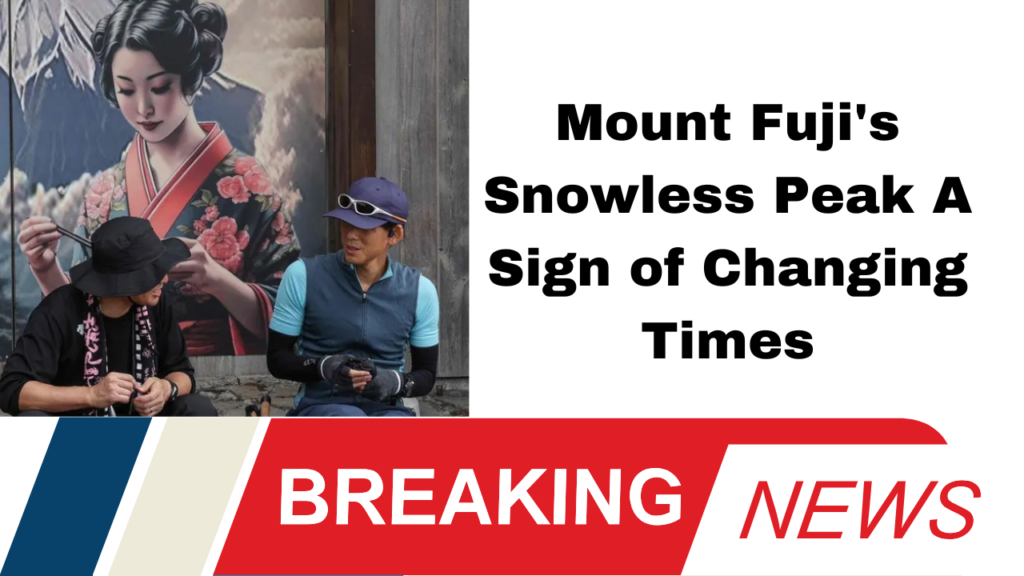Mount Fuji, Japan’s tallest and most iconic mountain, has long been a symbol of national pride, spirituality, and eternal beauty. But this year, the revered peak went without its signature snowy cap for the longest period on record causing both concern and reflection on the impact of climate change on Japan’s cultural landmarks.
A Historic First No Snow on Fuji Until November
For over 130 years, Japan has carefully documented the first snowfall on Mount Fuji, but 2023 marked a record-breaking delay. Typically, the first flakes appear on Fuji’s peak in early October, yet this year, the mountain remained bare until early November. According to local officials in Fujiyoshida City, the first observable snow was reported early on November 6, making it the latest first snowfall ever recorded since the Japan Meteorological Agency began tracking data in 1894.
Takefumi Sakaki, a local official from Fujiyoshida, expressed the collective unease in the community, saying, “This is the first time we haven’t seen snow on the mountain in November. Everyone feels strange not seeing snow.”
Fuji’s Snowy Cap A Cultural and Spiritual Symbol
Mount Fuji is more than just a natural landmark. It is deeply ingrained in Japan’s cultural, spiritual, and political history. Revered as a sacred site in both Shinto and Buddhist traditions, Fuji’s perennial snowy peak has been a symbol of eternity, standing unchanged through time.
The mountain has inspired countless artworks, poems, and myths. In ancient Japanese poetry, such as the Man’yoshu (compiled in the 8th century), Mount Fuji was described as a divine peak that had “stood since the parting of heaven and earth.” Over the centuries, the image of Fuji’s snow-capped peak became an enduring symbol of Japan’s unique cultural identity.
Climate Change and Mount Fuji A Direct Link
This year’s delayed snowfall on Mount Fuji is not an isolated incident but a stark reminder of the growing impact of climate change. Japan experienced its hottest summer on record in 2023, and unseasonably warm weather extended well into the autumn months. Tomoki Tanaka, a meteorologist at a weather office 20 miles north of Fuji, explained that while various factors contribute to the late snow, climate change is a significant culprit.
“The rising temperatures have affected weather patterns across the country, and Mount Fuji is no exception,” Tanaka said. The lack of snow is a clear signal of the environmental shifts that are now part of Japan’s reality.
Mount Fuji’s Snow A Symbol of Immortality and Stability
Historically, Mount Fuji has been viewed as an unchanging and eternal presence. In ancient Japan, particularly during the Edo period (1603–1868), Fuji was not only a natural wonder but also a political symbol. The shogunate used the image of Fuji to represent the stability of the country under their rule, emphasizing its permanence as a reflection of the enduring strength of the Tokugawa shogunate.
Fuji’s snow-capped peak was also a symbol of cultural continuity, particularly after Japan’s defeat in World War II. Over the centuries, the mountain has served as a symbol of resilience, national pride, and immortality.
Fuji in Art The Iconic Image That Defined Japan
One of the most well-known depictions of Mount Fuji comes from the 19th-century ukiyo-e artist Katsushika Hokusai, whose iconic “36 Views of Mount Fuji” series immortalized the mountain in a way that has captivated global audiences. Among these works is the famous woodblock print “The Great Wave off Kanagawa,” which shows a giant wave threatening boats, with Mount Fuji’s snow-capped peak in the background. This image has become synonymous with Japan’s cultural identity and is recognized around the world.
However, throughout history, depictions of Mount Fuji have varied, with occasional artistic representations showing the mountain without its snowy cap. These rare images often symbolized impermanence or change, challenging the traditional notion of Fuji’s eternal nature.
The Impact of Climate Change on Cultural Icons
As Mount Fuji’s snow becomes increasingly unreliable, it raises important questions about the future of Japan’s cultural symbols in the face of climate change. Timon Screech, a scholar at the International Research Center for Japanese Studies, remarked that “when something that’s supposed to be an icon of eternal Japanese selfhood is being altered because of climate change, it’s kind of like, ‘Wow, something’s really changing here.’”
The idea of Mount Fuji, a symbol of Japan’s national identity, being affected by the warming climate serves as a stark reminder of the broader environmental challenges that lie ahead.
What’s Next for Mount Fuji?
While Mount Fuji’s peak finally saw snow in early November, the delayed snowfall is a reminder that climate change is altering the natural world in unprecedented ways. This year’s event has led to discussions about the broader effects of global warming on Japan’s ecosystems, cultural heritage, and tourism industry. The snowless peak of Mount Fuji, once a constant symbol of Japan’s eternity, now stands as a powerful symbol of the urgent need for environmental action.
Japan’s response to these changes will shape the future of its cultural symbols, with Mount Fuji serving as a poignant reminder of the fragility of natural and cultural legacies in the face of a warming planet.
The late snowfall on Mount Fuji is not just a rare weather event; it’s a wake-up call for Japan and the global community. As climate change continues to alter weather patterns, symbols like Mount Fuji may no longer remain the timeless icons they once were. The shift in Fuji’s seasonal patterns highlights the pressing need for action on climate change, not only to preserve the environment but to protect the cultural heritage that defines nations.











More Stories
Netanyahu Under Fire as Leaked Documents Scandal and Hostage Crisis Deepen
Malik Mumbai’s 15 Crore Monthly Income ‘Haar Meri Jeet Apki Offer’ for WBBL 2024 Your Guaranteed Win or Refund!
The Endless Cycle of American Politics How Film Reflects the Presidential Race